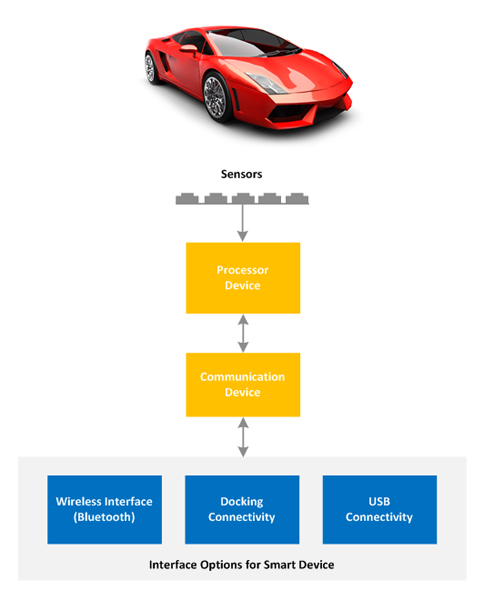Smart Enunciator for Automobiles

In recent times there has been tremendous growth in the market for smart devices. Not only have they become entrenched in our daily lives but are also becoming very powerful and business oriented. Indeed we depend on our smart devices for everyday tasks more than ever—and for tasks that didn’t ven exist only a year or two ago. And the possibilities that make the smart device ‘smart’ are continually changing. Automotive telemetry, for example is one such domain where smart devices are unlocking unprecedented levels of innovations, usefulness and benefits (safety, guidance, convenience & the like) for car drivers.
Given their processing power, versatility, popularity, and relatively low cost (compared to other monitoring / communication devices), smart devices indeed have a big role in designing tomorrow’s driver assistance systems. This trend of smart devices has therefore led to an increased demand for innovative functionalities inside a car, thereby causing stiff competition between automotive manufacturers / suppliers to provide latest technologies in cars. On the other hand, they are also required to reciprocate suitably to several recent findings where growing usage of smart device enabled touchscreen displays and in-car infotainment systems seem to be raising concerns of driver distraction. This certainly calls for a minimalistic, intuitive yet a simplified Human-Machine-Interface (HMI), which remains as easy as possible.
However, there is still a huge scope for innovation and research in smart device enabled accessories / appliances interlaced with voice-based HMI functions in a car. For example, consider having the following details of the car being announced on your smart device as you start your car:
- Oil level is adequate
- Car is due for service in 100 kms run
- Radiator liquid level is low, requires refilling of 1 litre
- Power steering liquid adequate
- Braking system liquid adequate
- Brake shoes worn out, replace during service
Although cars are becoming smarter by the mile, Ascenten, in light of some enlightening industry research as the one discussed above believes that automotive HMI design engineering should not limit its focus on exciting in-car infotainment gadgetry alone. Instead a meaningful and holistic HMI design approach, which is focused to enable safety and ease-of-use should be adopted. We took an initiative to translate this idea and developed a smart device enabled accessory armed with voice-based assistance, containing components to get analog data from car system, process them digitally and convert them into a presentable form onto a smart device based application.
The Processing Layer (or components) Includes:
- Various sensors that convert physical parameters to electrical signals
- Analog to digital (ADC) and digital to analog (DAC) converters
- Multiplexer, TTL-I/Os, high speed timers, RAM etc.
- Processing device with high-speed microcontroller
- Various communication stacks to enable use of USB, Bluetooth (including Bluetooth LE) etc.
- Interfacing options to connect devices, i.e., docking, USB etc.
- LCD screen to display onboard data
The Conceptual Block Diagram of the Solution:

The ADC module (part of Processor Device) converts the data received from various sensors in the car into digital information, which is then processed by the microcontroller and finally communicated through an appropriate interface to the smart device.
We used a PIC 32-bit family processor for development of the solution along with a Bluetooth stack and BT HCI Modules to communicate with an Android device. For connecting to an Android based smart device, we chose Android Open Accessory (AOA) protocol which establishes connection using USB or Bluetooth. When connected through Docking or USB, the device can also be charged by the car’s charging system.
The sensors and processor would analyze the following data:
- Low temperature measurement
- Oil temperature
- Water temperature
- General purpose low temperature
- Transmission temperature
- Exhaust gas temperature
- Fuel pressure
- Oil pressure
- Manifold pressure
- Brake pressure
- Nitrous pressure
- Transmission pressure
- Water pressure
- High temperature measurement
- Pressure measurement
- Supply voltage
- Battery discharge
- Fuel level measurement
- MPH (miles per hour)
- RPM (revolution per minute)
- Air fuel ratio measurement
- Warning indication
- Real-time data storage and playback function
With the above mentioned capabilities, voice-assistance will be enunciated through a smart device for the following features. Features enunciated when the car engine is first ignited:
- Oil level in engine
- Liquid level in radiator
- Liquid level in braking system
- Liquid level in gearbox
- Liquid level in power steering
- Liquid level in windscreen washer
- Battery charge condition
- Wheel air-pressure – all wheels
Assistance Enunciated at Specific Intervals While Driving,
- Vehicle speed
- Central locking status
- RPM
- Battery charge or discharge
- Low fuel level
- Engine overheating
- Drop in wheel air-pressure (indicating a puncture)
- Headlight bulb blow-out or malfunction
- Assistance enunciated while parking –
- Security system activated
- All doors locked
- All windows closed
- All electronic systems shutdown
- Battery not discharging
The above mentioned information is a partial list of features supported by the system. The list can be expanded to include more options, if desired.
While today’s savvy drivers yearn for a great ‘connected car’, adequate attention needs to be invested into making integrated in-vehicle communication simpler and safer. This concept solution from Ascenten aims to bring a similar model development to the fore. As one analyst rightly points out, the categorization of driving-related critical and non-critical functions will be essential when designing a safe and simple automotive HMI solution. We believe a voice-assisted HMI design with smart device enabled snappier responsiveness, thus warranting minimal driver distraction, will prove to be a great solution.




No Comments